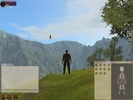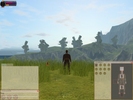 I've spent the last couple of days updating the version of the sky system Caelum that Ember uses. We've been using an almost two year old version, and there's been some nice recent improvements to it. It turned out to be fairly easy to do, some classes and interfaces had changed, but all in all it was a straight forward update process. The end result is a better looking world, if I might say so myself. The sky model has been refined, and support for clouds and sky transitions is more smooth and robust. One interesting addition is that it now uses an astronomically correct earth model, where both earth position and absolute day must be specified. This opens up some nice possibilities for virtual worlds, since it then is possible to specify where on the earth sphere your world should be placed, and get a different lighting model. A world placed at the north pole would have a very different day-night cycle than one placed at the equator. Alternatively, the server shouldn't assume that we're on an earth sphere and could instead just specify direct values for night and day cycle, as well as the sun's trajectory over the sky. That would require us to create our own solar system model classes to be used by caelum, but it's certainly doable. But there's a certain simplicity to just letting the server specify the longitude and latitude that's quite alluring.
I've spent the last couple of days updating the version of the sky system Caelum that Ember uses. We've been using an almost two year old version, and there's been some nice recent improvements to it. It turned out to be fairly easy to do, some classes and interfaces had changed, but all in all it was a straight forward update process. The end result is a better looking world, if I might say so myself. The sky model has been refined, and support for clouds and sky transitions is more smooth and robust. One interesting addition is that it now uses an astronomically correct earth model, where both earth position and absolute day must be specified. This opens up some nice possibilities for virtual worlds, since it then is possible to specify where on the earth sphere your world should be placed, and get a different lighting model. A world placed at the north pole would have a very different day-night cycle than one placed at the equator. Alternatively, the server shouldn't assume that we're on an earth sphere and could instead just specify direct values for night and day cycle, as well as the sun's trajectory over the sky. That would require us to create our own solar system model classes to be used by caelum, but it's certainly doable. But there's a certain simplicity to just letting the server specify the longitude and latitude that's quite alluring.Another issue is how to present the world during night. In the current caelum implementation it just gets darker, until you can't pretty much see anything. This isn't very nice for players, and would probably force them to always manually set the time to noon to be able to see something. Instead we want to provide a world that's as clear during the night as it is during the day. WoW does this splendidly, and we need to adapt something similiar. But until then we'll use the current hack, where the time of day on the client always is adjusted so it's sometime around noon, even when it's in the middle of the night on the server.
Another thing that's I've committed is some updates to the PagedGeometry system where it now uses classes specifically tailored for Ember, which renders near objects as entities while switching to imposter rendering for far away ones. Previously we had to use the DummyPage class and use the Entity::renderDistance functionality for hiding far away entities, but now that's all smoothly taken care of by classes which work directly with the PagedGeometry engine. There are still some issues with both performance and updates that needs to be taken care of, but it works much better now.
On the Worldforge front, there's two new exciting developements which has unfolded the last couple of weeks. One is that we now have a new Ember developer, Sean Ryan, who's just starting out getting a feel of the Ember code base. He's already taken upon himself to implement event logging as an initial task which is an excellent way to start.
The other development is that we're applying for the Google Summer of Code this year. We've already set up a wiki page for this purpose and will gladly accept any applicants or project ideas. If you think this is something for you, or if you know someone that might be suited, please get in touch with us, preferrably by using the mailing lists.




No comments:
Post a Comment